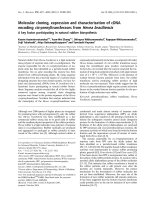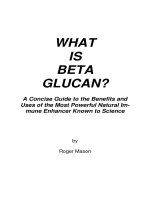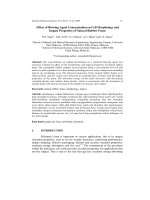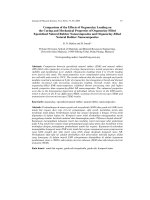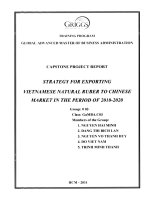Graft copolymerization of vinyltriethoxysilane onto deproteinized natural rubber
Bạn đang xem bản rút gọn của tài liệu. Xem và tải ngay bản đầy đủ của tài liệu tại đây (345.74 KB, 5 trang )
Journal of Science & Technology 134 (2019) 032-036
Graft copolymerization of vinyltriethoxysilane onto deproteinized natural
rubber
Nghiem Thi Thuong1*, Nguyen Van Dong2, Phan Trung Nghia1 and Seiichi Kawahara3
1
2
Hanoi University of Science and Technology - No. 1, Dai Co Viet Str., Hai Ba Trung, Ha Noi, Viet Nam
Insitute of Chemical-Materials, 17 Hoang Sam Street, Nghia Do ward, Cau Giay district, Hanoi, Vietnam
3
Nagaoka University of Technology, 1603-1 Kamitomioka-cho, Nagaoka, Niigata, Japan 940-2188
Received: October 03, 2018; Accepted: June 24, 2019
Abstract
In this work, graft copolymerization of vinyltriethoxysilane (VTES) onto deproteinized natural rubber (DPNR)
was carried out to prepare in situ nanosilica reinforced natural rubber. Graft copolymerization of VTES onto
DPNR was performed in latex stage with TBHP/TEPA as initiators with initiator concentrations of 0.033,
0.066 mol/kg-rubber and monomer concentrations of 1.05, 1.5 and 2.0 mol/kg-rubber. VTES conversion is
derived from silica content which is determined by buring method. The graft copolymers were characterized
by FT-IR and TEM. It was found that VTES conversion was about 80% and it is independent on initiator
concentration. The high conversion is believed to be due to auto hydrolysis of ethoxy groups in aqueous
solution and subsequent condensation to form in situ silica. Reinforcement effect of the in situ silica on
DPNR is investigated in term of tensile properties. The stress at break of in situ silica-reinforced natural
rubber was about 3 times higher than that of non-reinforced natural rubber. TEM images show that the silica
particles with the size less than 200 nm were well dispersed in NR matrix.
Keywords: natural rubber, VTES, graft copolymerization, in situ nanosilica, morphology
1. Introduction1
that a lot of silica particles separated out from latex
during coagulation due to poor interaction between
silica and SBR.
Silica-reinforced natural rubber (NR) is a very
unique material which provide several advantages
such as low-rolling resistance and strong wet-skid
resistance compared to carbon black [1]. Commonly,
silica-reinforced NR is achieved by mechanical
mixing or latex mixing, i.e. masterbatch. However,
the first always makes silica particle aggregate since
the active hydroxyl groups on silica surface are easily
condensed. The latter, on the other hand, needs a
silane coupling agent to create the linkages between
silica and NR particle. In order to solve these
problems, in situ synthesis of silica particles within
NR matrix using sol-gel method has been explored.
The sol-gel method is believed to be the novel
method to control the silica particle size and
morphology and it can be done in solid state, solution
state or latex state. In the solution state, it was applied
to introduce silica in various materials such as
Styrene Butadiene Rubber (SBR) [2], epoxydized NR
[3], isoprene rubber [4] and carboxylated
acrylonitrile-butadiene rubber. However, a lot of
organic solvents used limits its practical application.
Yoshikai [5] applied sol-gel process in latex state to
prepare silica-reinforced SBR. However, during a
process to prepare raw reinforced rubber, they found
Recently, graft copolymerization of vinyl
monomer provides a very useful technique to
introduce silica into rubber by the formation of
chemical linkages. Nurul et al. used this method to
prepare filler nanomatrix structure and found that the
molulus of graft copolymer increased after grafting
with vinyltriethoxysilane (VTES) [6,7]. However, no
structural information of the material was
investigated.
In the present work, we investigated graft
copolymerization of VTES onto DPNR and do
structural characterization to elucidate the formation
of functional groups in resulting materials. The
mechanical reinforcement of NR is associated with
in-situ silica morphology.
2. Experimental
2.1 Materials
The high ammonia natural rubber latex (HANR,
pH=9-10, 60% DRC) was received from Dau Tieng
rubber company. Vinyltriethoxysilane (VTES), tertbutyl
hydroperoxide
(TBHP)
and
tetraethylenepentamine (TEPA) were products of
Tokyo Chemical Industry of Japan. Sodium dodecyl
sulfate (SDS, 99%) was purchased from Kao
*
Corresponding author: Tel.: (+84) 988.265.825
Email:
32
Journal of Science & Technology 134 (2019) 032-036
chemicals company (Taiwan). Urea (99.5%) was
purchased from Merck (Germany). The other
chemicals were purchased from Sigma-Aldrich.
From silica content, VTES conversion is
estimated as following equation:
VTES conversion (%) =
2.2 Graft copolymerization
TEPA and TBHP
(nTEPA: nTHBP=1:1)
where 190 and 60 are molecular weights of
VTES and SiO2, respectively. VTES conversion in
this work is defined as how much VTES converted
into SiO2.
VTES
2.4. FT-IR measurement
DPNR 0.5%SDS, 20%DRC
N2 purging for 1hr,
under stirring
300C
2hr, 300C, under stirring
FT-IR measurement is performed in a JASCO
FT-IR 4600 spectrometer. The preparation of samples
is described as follows: a very thin film was prepared
by casting latex on a petri-dish and dried for 1 week.
Then it was placed on a KBr plate and inserted into
the FT-IR machine. The measurement is set for 100
scans, from 400 cm-1 to 4000 cm-1 at a resolution of 4
cm-1.
Gross latex
Evaporation 800C, 30 min
Graft copolymer
Fig. 1. Graft copolymerization of VTES onto DPNR
2.5 Mechanical properties
Graft copolymerization of VTES onto DPNR
was carried out as shown in Figure 1. First,
deproteinized natural rubber (DPNR) was prepared
by deproteinization of high ammonia natural rubber
(HANR) with 0.1 w/w% urea and 1w/w% sodium
dodecyl sulfate (SDS). After three times of
centrifugations, the final DPNR latex was adjusted to
20% DRC and SDS content was kept at 0.1 w/w%.
Before graft copolymerization, SDS was added to the
DPNR latex up to 1 w/w%. Graft copolymerization
was carried out with 1.05, 1.5 and 2.0 mol/kg-rubber
of VTES at 0.033 and 0.066 mol/kg-rubber of each
initiator. The reaction system was stirred at 400 rpm
at 300C for 2 hours after N2 bubbling DPNR latex for
1 hour at a speed of 300 rpm. Afterward, unreacted
monomer and free initiators were removed using a
rotary evaporator at 800C for 40 min. The gross
polymer was cast into a thin film and dried for a week
in a heating oven and one week in vacuum oven at
500C.
The tensile strength of samples was measured at
room temperature using a Tokyo Instron 5300
according to JIS K6251. The samples were cut by a
dumbbell-shaped no.7, the thickness of samples was
controlled around 1 mm measured by thickness gauge
(dial type) (Mitutoyo, Japan) under a crosshead speed
of 200 mm/min. Each sample was measured at least
three times.
2.6 Morphology observation
Morphology observation of resulting samples
was made using TEM (JEM-2100, JEOL) at
accelerating voltage of 200kV. The ultrathin section
of graft copolymer was cut by using a glass knife
equipped in a Reichert-Nissei FC S ultra-microtome
(Leica, Wetzlar, Germany) under liquid N2.
3. Results and discussion
3.1 VTES conversion
2.3 Silica content determination
In order to prepare various graft copolymers,
graft copolymerization of VTES was performed with
two initiator concentrations, that is 0.033 and 0.066
mol/kg rubber and at each initiator concentration,
monomer concentration is varied from 1.0, 1.5 and
2.0 mol/kg rubber.
Silica content was determined by burning
method. Weight of sample about 1g rubber was
burned in an electrical furnace at 600°C for 2 hours
in a clean porcelain cup (which is previously burned
at 600°C for 1 hour). The weight of cup before and
after burning was measured to determine ash of
sample. Ash after buring DPNR is also determined
and it will be substrated from ash of sample to
determine the actual silica content. The silica content
was calculated as the following equation:
silica content (phr) =
silica content * weight of rubber 190
*
weight of VTES
60
Table 2 shows the silica contents and VTES
conversions
for
six
conditions
of
graft
copolymerization. It could be seen that the silica
content depends on the VTES concentration and
insignificantly
dependent
on
the
initiator
concentration. On the other hand, at small VTES
concentration (1.0 and 1.5 mol/kg-rubber) the VTES
conversions are similar to each other but at higher
VTES conversion (2.0 mol/kg-rubber) it is decreased.
ash of sample - ash of DPNR
*100
weight of sample
33
Journal of Science & Technology 134 (2019) 032-036
This suggests that when too much VTES is added to
the reaction, the conversion is decreased. The reason
may be due to the steric hindrance of Si-O-Si groups
onto the hydrolysis and condensation of other ethoxy
groups and silanol groups, respectively. Therefore, it
can be inferred that low VTES concentration (such as
1.05 and 1.5 mol/kg rubber) are the suitable
concentrations to achieve high conversion.
(a) DPNR-g-VTES
Abs
(b) DPNR
(a)
Table 2. Silica contents and VTES conversions of
graft copolymers
Silica
VTES
Samples
content conversio
(phr)
n (%)
DPNR-g-VTES-0.033-1.05
5.25
82.9
DPNR-g-VTES-0.033-1.5
7.45
82.5
DPNR-g-VTES-0.033-2.0
9.64
80.0
DPNR-g-VTES-0.066-1.05
5.20
82.5
DPNR-g-VTES-0.066-1.5
7.50
83.9
DPNR-g-VTES-0.066-2.0
9.28
76.7
(b)
4000
3600
3200
2800
2400
2000
1600
1200
800
400
Wave number (cm-1)
(a) DPNR-g-VTES
(b) DPNR
Abs
1206
3.2 FT-IR spectroscopy
To elucidate the structure of graft copolymer,
FT-IR measurement was carried out. Figure 2 shows
the FT-IR spectra for DPNR and DPNR-g-VTES
0.033-1.05. The characteristic absorption bands of
DPNR were maintained and still appeared in the FTIR spectrum for DPNR-g-VTES. However, there are
several new absorption vibration bands appeared in
spectrum of DPNR-g-VTES. These characteristic
absorptions were registered in Table 2. Absorption at
3000-3500 cm-1 was attributed to Si-OH; absorption
at 1035-1206 cm-1 was attributed to Si-O-Si as well as
Si-O-C groups. The arisen of these absorption bands
were evident to confirm that the in-situ silica was
successfully formed in NR matrix. It is noted that the
band at 1206 cm-1 belongs to the vibration of Si-O
linking to ethoxy groups in VTES and the band at 960
cm-1 belongs to Si-OH in silanol [8,9]. This implies
that absorption peak at 1206 cm-1 is due to the
incomplete hydrolysis of ethoxy groups and the peak
at 960 cm-1 is due to the free OH groups linking to Si
atom. It is consistent with the broad absorption band
in the region of 3000 to 3500 cm-1, which belongs to
the OH group. FT-IR spectrum is confirmed to give
very useful information on the hydrolysis and
condensation of ethoxy groups and therefore the
formation of silica structure in the elastomer matrix.
1124
1035
950
(a)
(b)
2000
1600
1200
800
Wave number (cm-1))
400
Fig. 2. FT-IR spectra of DPNR and DPNR-g-VTES
(a) from 400-4000 cm-1 and (b) from 400-2000 cm-1
The formation of in situ silica was proposed to
occur during graft copolymerization as illustrated in
Figure 3, where we assume the graft
copolymerization took place followed by the
hydrolysis and condensation to generate the silica
particle on the NR molecule. Through the chemical
linkages formed by graft copolymerization, the in situ
silica is expected to enhance NR properties without
using silane coupling agent.
Table 2. Assigments of FT-IR absorption bands for
graft copolymer
Wave number (cm-1)
Assigments
3400
Si-OH
1206
Si-O-C (VTES)
1124
Si-O-Si
1035
Si-O-Si
950
Si-OH (silanol)
Fig. 3. Formation of in situ silica in during graft
copolymerization of VTES
34
Journal of Science & Technology 134 (2019) 032-036
3.3 TEM
10
The presence of in situ silica in graft copolymer
is further confirmed by morphology observation with
Transmission Electron Microscopy (TEM). Figure 4
exhibits TEM images of DPNR-g-VTES 0.033-1.5 at
magnifications of 10,000 and 5000. In Figure 4, the
dark domains represent silica particle and the bright
domains represent NR. As can be seen, the silica
particles are well dispersed in NR matrix. When we
increase magnification, it is clear to estimate the size
of silica particle is less than 200 nm.
(c)
9
8
Stress (Mpa)
7
(a)
6
(b)
5
4
(d)
3
2
1
In addition, the in situ silica particles are the
sphere in shape. This may be due to the hydrophilic
nature of silica particle, which is not compatible with
the hydrophobic nature of NR particle. Therefore, the
growth
of
silica
particle
during
graft
copolymerization is frequently hindered by molecular
interaction between them. Therefore, silica particles
tend to decrease their surface area. The formation of
sphere silica particles is the result of such molecular
interaction.
0
0
200
400
600
Strain (%)
800
1000
1200
Fig. 5. Stress-strain curves for DPNR-g-VTES (a)
0.033-2.0; (b) 0.033-1.5; (c) 0.033-1.05 and (d)
DPNR
8
7
(a)
(b)
Stress (Mpa)
6
(c)
5
4
(d)
3
2
1
(a) x 5000
0
(b) x10,000
0
Fig. 4. TEM images of DPNR-g-VTES 0.033-1.5 at
two magnifications (a) x5000 and (b) x10,000
200
400
600
800
1000
1200
1400
Strain (%)
Fig. 6. Stress-strain curves for DPNR-g-VTES (a)
0.066-2.0; (b) 0.066-1.5; (c) 0.066-1.05 and (d)
DPNR
3.4 Tensile strength
To investigate the reinforcement of in situ
nanosilica on mechanical properties of graft
copolymer, the stress-strain curves of the materials
were made.
Figure 6 displays the stress-strain curves for
DPNR-g-VTES prepared with initiator concentration
of 0.066 mol/kg-rubber. It is found that the stress at
break of the samples increased as the monomer
concentration increased, which are different from
those prepared at initiator concentration of 0.033
mol/kg rubber. The stress at same strains of the
samples depends on VTES concentration, similar to
those prepared with initiator of 0.033 mol/kg rubber
The stress at break of samples at 0.066 mol/kg rubber
of initiator has higher than those at 0.033 mol/kg
rubber, except sample prepared at initiator
concentration of 0.033 mol/kg rubber and VTES
concentration of 1.05 mol/kg rubber. The highest
tensile strength for DPNR-g-VTES 0.033-1.05 maybe
explained to be due to the high conversion during
Figure 5 shows the stress-strain curves for
DPNR-g-VTES at various VTES concentrations at
0.033 mol/kg rubber of initiator concentration. It
could be seen that the graft copolymer prepared with
VTES concentration of 1.05 mol/kg-rubber achieved
the highest stress at break (9 MPa), which is nearly
three times higher than that of DPNR. Furthermore,
the stress at same strain for each sample is dependent
on the VTES concentration.
35
Journal of Science & Technology 134 (2019) 032-036
butadiene rubber/silicon dioxide hybrid materials, J
Appl Polym Sci, 92 (2004), 798-803.
graft copolymerization and may be the good
distribution of silica particles in NR matrix.
[3]
A. Bandyopadhyay, M.De Sarkar, A.K. Bhowmick,
Epoxidised
natural
rubber/silica
hybrid
nanocomposite by sol-gel technique: Effect of
reactants on the structure and properties, Journal of
Materials Science, 40, (2005) 53-62.
[4]
Messori.M, Fiorini.M, Isoprene rubber filled with
silica generated in-situ, Journal of Applied Polymer
Science, 119 (2010), 3422-3428.
[5]
Yoshikai.K,
Ohsaki.T,
Furukara.M,
Silica
reinforcement of synthetic diene rubbers by sol-gel
process in the latex, Journal of Applied Polymer
Science, 85(2002), 2053-2063.
[6]
Nurul H.Y, Kosugi.K, Fukuhara.L, Yamamoto.Y,
Kawahara.S, Preparation and properties of natural
rubber with filler nanomatrix structure. Colloid
Polymer Science, 239 (2015), 2249-2256.
[7]
Kawahara.S, Nurul H.Y, Noguchi.K, Kosugi.K,
Yamamoto.Y,
Organic-Inorganic
nanomatrix
structure and properties of related natural occuring
rubbery, Polymer. 55(2014), 5024-5027.
This research is funded by Vietnam National
Foundation
for
Science
and
Technology
Development (NAFOSTED) under grant number
104.02-2017.35
[8]
Natalia A.Agudelo, Leon D.Perez, Betty L. Lopez, A
novel method for the synthesis of polystyrene-graftsilica particles using random copolymers based on
styrene and vinyltriethoxysilane, Applied Surface
Science 257 (2011) 8581-8586.
References
[9]
Yin.C, Zhang.Q, Gu.J, Zheng.J, Gong.G, Liang.T,
Zhang.H,
In-situ
silica
reinforcement
of
vinyltriethoxysilane-grafted styrene-butadiene-rubber
by sol-gel process, Journal of Applied Polyme
Science, 128 (2013), 2262-2268.
4. Conclusion
In situ nanosilica was successfully formed in
NR during graft copolymerization of VTES onto NR.
The silica content is found to depend on VTES
concentration but not depending on the initiator
concentration. The conversion decreased as VTES
concentration
increased.
From
structural
characterization by FT-IR, silica particles still contain
silanol groups and unhydrolysed ethoxy groups with
a small amount. The silica particles have been found
to be homogeneously distributed in NR matrix with
the sphere shape and size less than 200 nm. The
reinforcement of nanosilica is significantly enhanced
through formation of chemical linkages between
silica and NR. Graft copolymerization is, therefore, a
useful tool to incorporate in situ silica to achieve
good reinforcement without using silane coupling
agent.
Acknowledgments
[1]
Ono.S, Kiuchi.Y, Sawannobori.J, Ito.M, Structure
development in silica filled rubber composite,
Polymer Internation, 48 (1999), 1035-1041.
[2]
Maria Augusta de Luca, Tais Espindola Machado,
Renan Beretta Notti, Marly Maldener Jacobi,
Synthesis and characterization of epoxidized styrene-
36


